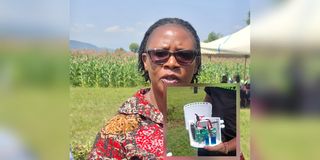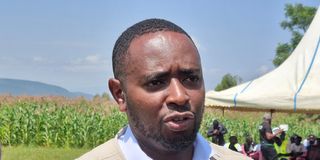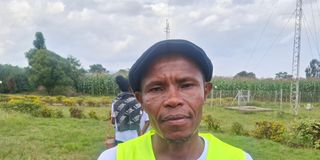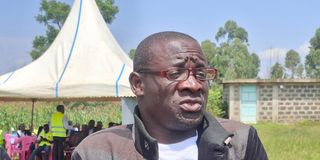How Nakuru is using AI sensors to reduce air pollution

Egerton University’s professor of Environmental Health, Professor Wilkister Moturi during an interview on July 1,20205. (Insert) One of the AI powered air quality sensors to be installed across various wards in Nakuru City.
Nakuru County is set to install 20 additional low-cost, AI-powered air quality sensors across various wards in Nakuru City to better monitor pollution hotspots.
The move aims to build a comprehensive dataset that can track pollution trends and guide more targeted, predictive responses to the city’s escalating air quality challenges.
These new devices will build on an earlier pilot project launched in 2021, which saw eight sensors placed at strategic locations to test real-time air quality monitoring in an urban setting.
Gitau Thabanja, the Nakuru City Manager, explains that the county is expanding from the initial eight sensors to 28 by the end of the RESPIRA project.

Gitau Thabanja, the Nakuru City Manager during an interview on July 1,2025.
“This will give us more data to work with, and that data will inform how the government and the city prioritize projects,” he said. “We don’t want to allocate resources blindly. We want decisions to be based on evidence.”
According to him, the sensors will show where the city needs to act. For example, data from a sensor near Mashambani terminus has revealed high emissions in the area, prompting the county to green the adjacent Lions Garden as a carbon sink.
“That’s one case where the sensor helped guide action,” he notes, adding that sensor data from Nyayo Gardens has also shown improved air quality since the garden’s renovation, proving that restoring green spaces has an impact.
“We’ve seen this with our own data,” he says. “And we hope to keep allocating resources to improve air quality in the areas we’ve identified.”
Speaking during the launch, Ezekiel Gitau, a Ward Climate Change Planning Committee (WCCPC) member previously trained as a citizen ambassador ‘Angawatcher’ under the RESPIRA project, says some of the efforts they have been running for three months are already yielding results.

Ezekiel Gitau poses for a photo during an interview on July 1,2025.
“We have been recording what the air is like every day, and residents have been sharing with us all kinds of feedback. For instance, in my ward, Biashara, things like sewer leaks, open burning of garbage and even human waste seem to be the biggest points of pollution,” he explains noting that the leaks pose some of the worst health risks and during their time they have been able to call for their fixing improving their air quality.
He notes that the new sensors will help tremendously by adding technical evidence they can share with the community, showing people exactly what kind of air they are breathing and encouraging them to change behaviors that cause pollution.
Over in Nakuru West, Stephen Ogutu alias Obama, says they have been conducting community awareness and one on one discussions with their communities on the quality of air in their respective areas.

Stephen Ogutu alias Obama, during an interview on July 1,2025.
“In Barut, we have a sewage plant that affects the community, flooding from Lake Nakuru where fishing is happening, and along the River Ndarugu, there’s air and water pollution from sand harvesting and truck traffic,” he says. “All these activities contribute to air pollution. Hence, the data we’ve collected is to help us counter this and engage our members on how to go about it.”
Obama notes that a pressing challenge is convincing some young people that the sensors are for measuring pollution, not tracking individuals, and hopes that soon they will be able to understand the purpose and come on board.
According to Egerton University’s professor of Environmental Health, Professor Wilkister Moturi, so far, the additional AI-powered sensors will be deployed across the eleven wards in Nakuru East and West sub-counties.
In Nakuru West, the locations include Kaptembwo Primary school, Soko Mjinga, Gioto social hall, Kabarak Meteorological office, Nakuru West Clinic, Nakuru West member of parliament office, Hadassah Community Hall, Worldwide Gospel Church of Kenya, Kapkures Center at the DC’s office, Ingobor dispensary, Barut Primary school, and Barut dispensary.
Whereas in Nakuru East, the mapped areas include Lion’s Garden, Free Area market, Wakulima market, Mburu Gichua Primary School, Kiratina, Racetrack, Kaloleni, and Nakuru Primary Schools, adds Prof. Moturi, who is also a co-principal investigator in the project.
The previous eight high-tech sensors are installed in Nyayo Gardens, Nakuru Athletics Club, Golden Life Mall, NAWASSCO, Kingdom Seekers Church, Nakuru High School, the County Headquarters, and the Nakuru Teaching and Referral Hospital.

